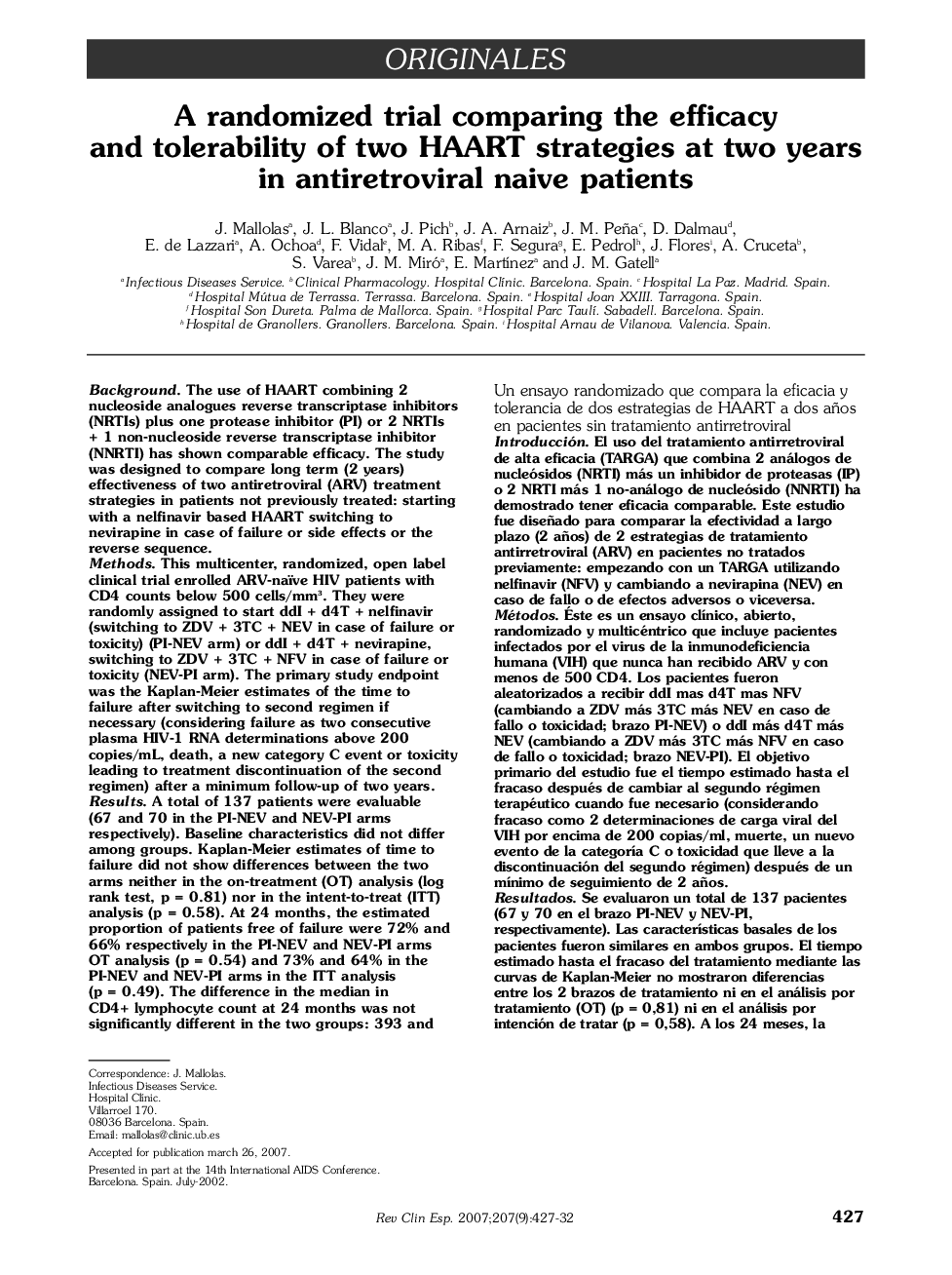| Article ID | Journal | Published Year | Pages | File Type |
|---|---|---|---|---|
| 3828375 | Revista Clínica Española | 2007 | 6 Pages |
BackgroundThe use of HAART combining 2 nucleoside analogues reverse transcriptase inhibitors (NRTIs) plus one protease inhibitor (PI) or 2 NRTIs + 1 non-nucleoside reverse transcriptase inhibitor (NNRTI) has shown comparable efficacy. The study was designed to compare long term (2 years) effectiveness of two antiretroviral (ARV) treatment strategies in patients not previously treated: starting with a nelfinavir based HAART switching to nevirapine in case of failure or side effects or the reverse sequence.MethodsThis multicenter, randomized, open label clinical trial enrolled ARV-naïve HIV patients with CD4 counts below 500 cells/mm3. They were randomly assigned to start ddI + d4T + nelfinavir (switching to ZDV + 3TC + NEV in case of failure or toxicity) (PI-NEV arm) or ddI + d4T + nevirapine, switching to ZDV + 3TC + NFV in case of failure or toxicity (NEV-PI arm). The primary study endpoint was the Kaplan-Meier estimates of the time to failure after switching to second regimen if necessary (considering failure as two consecutive plasma HIV-1 RNA determinations above 200 copies/mL, death, a new category C event or toxicity leading to treatment discontinuation of the second regimen) after a minimum follow-up of two years.ResultsA total of 137 patients were evaluable (67 and 70 in the PI-NEV and NEV-PI arms respectively). Baseline characteristics did not differ among groups. Kaplan-Meier estimates of time to failure did not show differences between the two arms neither in the on-treatment (OT) analysis (log rank test, p = 0.81) nor in the intent-to-treat (ITT) analysis (p = 0.58). At 24 months, the estimated proportion of patients free of failure were 72% and 66% respectively in the PI-NEV and NEV-PI arms OT analysis (p = 0.54) and 73% and 64% in the PI-NEV and NEV-PI arms in the ITT analysis (p = 0.49). The difference in the median in CD4+ lymphocyte count at 24 months was not significantly different in the two groups: 393 and307 CD4 cells/mm3 in the PI-NEV and NEV-PI arms respectively (p = 0.167).The incidence of adverse events (AEs) in the two arms was very similar: 50 (75%) in the PI-NEV and 54 (70%) in the NEV-PI group, as it was for grade 3-4 AEs leading to drug switching.ConclusionAt two years both treatments strategies (PI-NEV vs NEV-PI) had a high and comparable efficacy and were generally well tolerated.
IntroducciónEl uso del tratamiento antirretroviral de alta eficacia (TARGA) que combina 2 análogos de nucleósidos (NRTI) más un inhibidor de proteasas (IP) o 2 NRTI más 1 no-análogo de nucleósido (NNRTI) ha demostrado tener eficacia comparable. Este estudio fue diseñado para comparar la efectividad a largo plazo (2 años) de 2 estrategias de tratamiento antirretroviral (ARV) en pacientes no tratados previamente: empezando con un TARGA utilizando nelfinavir (NFV) y cambiando a nevirapina (NEV) en caso de fallo o de efectos adversos o viceversa.MétodosÃste es un ensayo clÃnico, abierto, randomizado y multicéntrico que incluye pacientes infectados por el virus de la inmunodeficiencia humana (VIH) que nunca han recibido ARV y con menos de 500 CD4. Los pacientes fueron aleatorizados a recibir ddI mas d4T mas NFV (cambiando a ZDV más 3TC más NEV en caso de fallo o toxicidad; brazo PI-NEV) o ddI más d4T más NEV (cambiando a ZDV más 3TC más NFV en caso de fallo o toxicidad; brazo NEV-PI). El objetivo primario del estudio fue el tiempo estimado hasta el fracaso después de cambiar al segundo régimen terapéutico cuando fue necesario (considerando fracaso como 2 determinaciones de carga viral del VIH por encima de 200 copias/ml, muerte, un nuevo evento de la categorÃa C o toxicidad que lleve a la discontinuación del segundo régimen) después de un mÃnimo de seguimiento de 2 años.ResultadosSe evaluaron un total de 137 pacientes (67 y 70 en el brazo PI-NEV y NEV-PI, respectivamente). Las caracterÃsticas basales de los pacientes fueron similares en ambos grupos. El tiempo estimado hasta el fracaso del tratamiento mediante las curvas de Kaplan-Meier no mostraron diferencias entre los 2 brazos de tratamiento ni en el análisis por tratamiento (OT) (p = 0,81) ni en el análisis por intención de tratar (p = 0,58). A los 24 meses, la proporción estimada de pacientes libres de fracaso fue del 72 y el 66%, respectivamente, en el brazo de PI-NEV y NEV-PI en el análisis OT (p = 0,54) y del 73 y el 64% en el PI-NEV y NEV-PI en el análisis ITT (p = 0,49). La diferencia en la mediana de linfocitos CD4 a los 24 meses no fue significativamente diferente entre ambos grupos: 393 y 307 CD4 células/mm3 en el grupo PI-NEV y NEV-PI, respectivamente (p = 0,167). La aparición de efectos adversos del tratamiento fue muy similar: 50 (75%) en el grupo PI-NEV y 54 (70%) en el grupo NEV-PI, asà como los efectos adversos de grado 3-4 que llevaron a la discontinuación del tratamiento.ConclusiónLas estrategias de tratamiento PI-NEV frente a NEV-PI tienen una eficacia alta y comparable a los 2 años de seguimiento y en general fueron bien toleradas.
